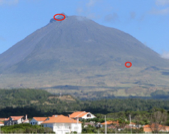Collaborative Research Project to Study Long-range Transported Aerosols
Collaborative Research: Chemical, Physical, and Radiative Properties of North Atlantic Free Tropospheric Aerosol after Long-range Transport
NSF Atmospheric Chemistry Program, 2011-2014

Picture of Pico Mountain with location of the mountaintop observatory (top red circle) and of the visitor center (lower circle).
The radiative forcing of aerosol is not determined solely by local sources and fresh emissions, but also by changes in the microphysical and chemical properties with atmospheric transformation. The composition of continental pollution outflow is altered by mixing, an array of chemical reactions, phase changes, and removal processes. Thus, the properties of aerosol and trace gases in downwind regions are impacted by the outflow of pollutants, chemical transformation, and sinks during transport. The importance of addressing the contribution of long-range transported pollutants in air quality legislation has motivated the implementation of the Task Force on Hemispheric Transport of Air Pollutants (HTAP). In the 2010 HTAP report, the Task Force recognizes the significance of intercontinental transport, and recommends further observational studies of long-range transported pollutants to better quantify short-lived climate forcers. To work toward this aim, we propose a combination of new and continued measurements of light absorbing aerosol and co-pollutants at the Pico Mountain Atmospheric Observatory. The Observatory is located in the central North Atlantic, at 2.2 km a.s.l. on Pico Island in the Azores archipelago. The Observatory resides well above the marine boundary layer and receives air characteristic of the lower free troposphere during most times. In previous research, the site has been found to be highly valuable for studying continental outflow that is 3-20 days old and has not been affected by the ocean and local emissions since leaving the continent.
Consequently, this site is an ideal location to investigate pollution transport events originating from human activities in North America, from fires in the boreal regions, and occasionally from Saharan dust intrusions.
